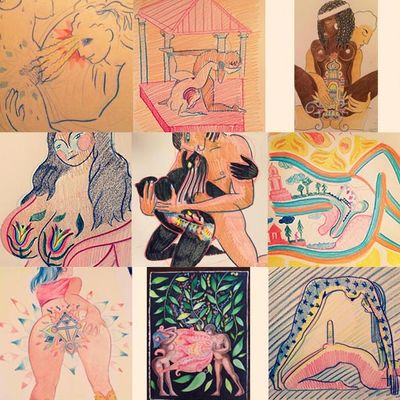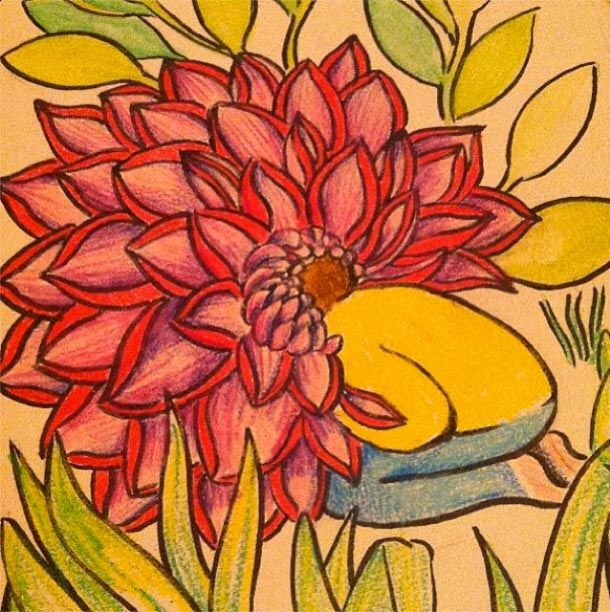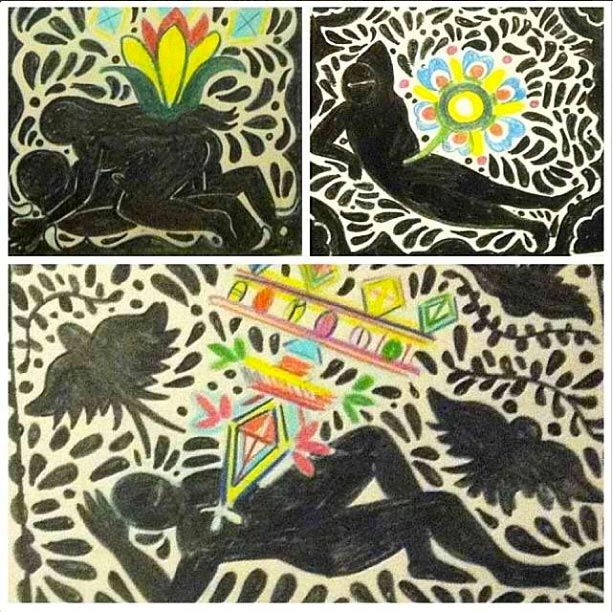
For me, Instagram is a land of the midnight sun, a wide-open place that’s always lit up, bristling with visions, pictures, strangers, shooting stars, screwballs, and well-known artists posting images from everywhere, together creating this immense abstract missive or amazing rebus that seems to speak just to me, the curious curator of my own lit-up Instagramland. Strangest in this strange land is that 123,000 people now follow me. Or are following their idea of me: New York Magazine’s art critic acting out in pictures online.
On Instagram, I’m searching. But for what? Pictures. My first, best, last, maybe only real language. I love to look. At anything. Anytime. Especially in this still moderately unplumbed space — in terms of openness and weirdness, far beyond the tightening conservatism of Facebook and the whip-fast witticisms of Twitter. What else am I looking for? And why? To be sure, this is a sort of pre-screened “community,” where standards of taste and obscenity are strictly enforced, or self-enforced, by users intuiting and seeing the unseen, omnipresent censor-world. It only barely echoes the Wild West freedom of expression that was once the domain of the very early social-media internet. But patrolled and not, there is more wildness there than elsewhere on the web — or off it. I’m writing this now because I found someone, an artist, whose work justifies this interest and gives just a tantalizing taste of all that promise and all those unknowns who must be out there. But more about that later — first, back to Instagram itself.
Why else do I obsess over Instagram? Passive voyeurism, of course. All these pictures are authored, but I know only a tiny handful of who the authors are, so there’s that mystery and titillation. So these pictures seem to come from nowhere or from other places, allowing glimpses into other people’s lives. I have tastes. I don’t like kids, but pictures of them are okay. But not dogs or cats. (Although artist Andrew Kuo’s cat and dog pics are all hysterically funny and hysterically cute.) Worst are all the food photographers, all the people who go to India or China or somewhere spectacular and then just post endless close-ups of their food. I block these people at once. Ditto the dog-picture people.
I love Instagram comedians like the Real Liz Carey, the Fat Jewish, damhave, and Fuck Jerry (who everyone thinks is me because of the name). These are quasi-comics finding this pictures-only medium to tell jokes, Duchampian and otherwise. Artist Jason Musson, a.k.a. Hennessy Youngman, excels here, too. So does the amazing Brad Phillips. The artist Rick Herron has invented a whole maplike art that looks great and may only exist on Instagram. Rob Pruitt’s pictures of books and trinkets tend to tickle. I’ve no idea where he gets them, but artist Tony Oursler’s pics always amaze. As do Francis Stark’s, Oliver Wasow’s, and Thaddeus Strode’s. K8 Hardy’s feed is a killer anti-fashion fashion magazine and should be published by MoMA’s own P.T. Barnum, Klaus Biesenbach, who is known for his pics of wherever he travels, and as a curator, he travels loads, even if he does seem to be with other curators, Marina Abramovic, and James Franco an awful lot of the time. His peripatetic curatorial counterpart, Hans Ulrich Obrist, posts gnomic koans by famous artists. I have no idea what most of these mean, but since they’re posted by this Anton Artaud look-alike artistic gadfly I click “like” so I seem cool. I’ve found some great real photographers on Instagram, like Tempster Returns and Ashley Hicks 1970. Though it turns out that some of them may be famous already (Tempster Returns is, I just learned, Ed Templeton!). I’ve never seen a bad post by fashion designer Duro Olowu; he should get a MacArthur for his eye alone. Artist Raven Smith is a close second. Critics David Rimanelli and Alison Gingeras have long been posting their own taste in great or lesser-known art to excellent effect. Met Director Thomas Campbell posts behind-the-scenes shots of museum installations. And the Met’s actual Instagram feed is pretty spectacular. Adam Lindeman and Simon de Pury, who get around almost as much as the curators, are doing great, too.
What’s more, I love the many adults who have an unexplained need to dance naked not in public, the way all artists do. But the need to do it on social media, on Instagram. How their almost- and totally naked pictures don’t get censored by Instagram when I’ve had pictures of a cow sniffing a man’s ass get deleted and a 17th-century French painting axed because it had a wisp of dark public hair is beyond me. Maybe they have a magic kundalini body-power that makes them pictorially invulnerable to censors and the censorious. Speaking of which, I love Richard Prince’s crazed Instagram account. Or I loved it, until he intentionally crashed it by posting nip pics and other naughty bits. By now everyone knows he got lambasted by Twitter critics who tsk-tsked that anyone would be so uncouth and “sexist.” Bad Richard Prince. Very bad. Me, too. I got called “perv” simply for not “condemning” Prince’s Instagram “sexism.” Instagram is also great for semi-shut-ins like me. I didn’t leave the city this fall and owe my entire impression of this autumn to photographers Todd Eberle and Carolyn Marks Blackwood and their beautiful leaf and tree pictures.
But what I think I’m really looking for is what I’m always looking for, what I went looking for once upon a time on Facebook and on Twitter: unknown art. Artists who are on social media or Instagram but who haven’t shown in so-called “real” galleries in New York, Los Angeles, Berlin, or London. Artists who don’t have reputations, aren’t in biennials, aren’t collected or celebrated in any way, and yet are really good artists. Maybe great ones. I’m not looking for the art of the insane, as presumably the insane wouldn’t maintain coherent Instagram accounts. Why? I love galleries, but often it seems as if the system that’s in place precludes flukes, unexpected twists of artistic fate, things that might not otherwise make it past the waves of gatekeepers. The New York Times reported that Irish artist Genieve Figgis and Canadian BP Laval were found by Richard Prince on Instagram. Figgis has since shown at Half Gallery in New York and had a book of her work published. Raymond Pettibon supposedly found the work of Andrew Pope on Instagram.
I love the idea of finding something that I might not have found otherwise. So I follow one unknown name to another who has “liked” something on another unknown person’s account, who has then “liked” something on another person’s feed, and so on. Linking. Looking. And looking some more. And I have found plenty. I’ve looked for the many who are much better photographers than they think they might be, and have already come across all these great “outsider photographers” who are less predictable than many of the so-called “professional photographers” and generating newish pictorial ideas about color, composition, subject matter, and cropping. I hope pictures like this might gain greater entrance into popular publications and art galleries. Soon.
But it’s not photography I’m looking for, or only pictures of strange things, odd places, visual puns, or formal photographic sensibilities. To find something else. Something before this technology is dated and soon not used at all. In this odd golden moment of in-between life, I am looking for art by someone who identifies as an artist and calls what they make “art.” Not a hobby or a sideline activity. Maybe because there’s already so much clever visual neoconceptualism wherever you look, from galleries and museums to print and television ads, that’s not what I’m after, either. Specifically, I’m looking for painting or sculpture. (Although before Instagram’s time passes, I hope to find great video artists who post little loops that work at this scale, this close to the face, seen in private from one’s own hand with only this sound system available.) I am looking for painting or sculpture that might simply work in a gallery as-is, without explanation, backstory, or tale. I’ve been doing this for almost the whole time I’ve been on Instagram, which is only a couple of years (I’m nothing if not a late adapter). Daily. Wanting to discover a new artist, not nessesarily a “great artist,” but art that I could get excited about — someone who seemed to come up through Instragram, for whom it was a medium as much as a platform. Like if someone wanted to be a postage-stamp artist or a Facebook or Twitter artist.
Four months ago, I stumbled on something. Someone who’s name I still don’t know but whose work has a real lusciousness to it, a vision, a fecund sense of color and line, internal scale, odd order, and saucy subject matter. The artist’s Instagram name is Alphachanneling. I thought that the artist was a woman. I wrote to her. It turns out it is a man; he lives near San Francisco. (I should have known just from the New Age side of his work that it was in the Bay area.) At one point the artist told me his name but I lost it in a chain of emails, which seems fine. This fits the profile of what I was looking for: Just as I like to go into galleries not knowing about the art or pre-packaged explanation, I like that I only have my eye to go on with Alphachanneling. Before anyone sniffs about an art critic liking something he’s never actually set eyes on, I can only say I love a lot of art I’ve never seen in the flesh; everything from the Ghent Altarpiece to the Lascaux Caves in southwestern France, and almost everything I’ve never seen but that rocks my world from India and Korea. Moreover, in some ways, this art only exists on Instagram for me; this is its primary format.
After lurking on and “liking” his feed, I messaged Alphachanneling on Instagram. I asked him for a very short statement about his work. Here’s some of what I got back. It fits the work to a tee. “Alphachanneling is a Swiss-born American artist based out of Oakland, California.” (I love how he refers to himself in the third person!) “My artwork is a devotional prayer to the feminine principal.” (I knew it! The worship of female power, the female body, and pleasure. It wasn’t just a “perv,” but someone obsessed with the idea of something. Someone inexplicably driven to make a visual philosophy.) “Central to my process is … channeling, an ongoing cultivation through a deep relationship I have with several master-teachers.” (Makes me wish more in the art world talked about “channeling master-teachers” instead of nattering on about their goddamn “practice” like they’re doctors.) “Spiritual in practice, the images I produce are simple thought-waves … I look towards Taoism and tantra, pornography and folk art, BDSM and the divine, the mystical and the occult, indigenous and outsider art alike … Alphachanneling lives in a boundless world called the Utopian Erotic, a world of magical pussy, radiant women, bedroom jungles and temples of light.” (Please, a note to Facebook dignity police and Twitter critics: It wasn’t me who raised “BDSM” or said “magical pussy.”)

Now I’ll go art-critic on Alphachanneling’s ass. All of Alphachanneling’s art is erotic without coming off as blatantly gratuitous bad-boy, cartoony, big-tits/big-dick sexism, although he can get close to this occasionally. (A few slap-happy images are just happy buxom voluptuaries.) One image, titled The Source, a depiction of a man sniffing or eating a large, lotus-like red flower, apes the vibrant pinks, yellows, and greens of tantric art. In Surrender, three different figures are shown in decorative patterned fields. One personage is surrounded by birds and with what looks like a mystic crystal mushrooming from its breasts; another, with a rainbow-colored flower growing from its groin. This work echoes Chris Ofili’s later-period black palate and patterning. There’s an outsider-ish Henri Rousseau quality to some of his careful rendering and large, leafy jungle settings, as if these figures inhabited some netherworld Garden of Earthly Delights. And contemporary artists like Ella Kruglyanskaya, Amy Bessone, and Nadine Faraj come to mind. In one beauty, a male’s head seems to beam rays into a vibrating vulva. Or it’s a kind of vulva mind-meld on the man’s head. A companion drawing finds a woman doing the same thing, or having the same thing done by an erect penis, which she clasps happily with both hands. Either way, these drawings have a delightful Sigmar Polke easiness of line and simplicity of funny form and dicey subject matter. Alphachanneling echoes a couple of my favorite artists, including Ernst Ludwig Kirchner and some of his other fellow German Expressionists. In a number of lovely embroiderylike fields and concentric lines depicting coitus, cunnilingus, and coupling in all forms, with any number of people, and mixed races, with flowers standing in for genitals, I am reminded of excellent outsiders like Minnie Evans and Friedrich Schroder-Sonnenstern. In Love Science, Harmonic Awakening of the Living Temple, and other wonders, we get great X-ray visions of penetration in rainbow colors.

Someday I’d like to see Alphachanneling’s art in the flesh to size up its scale, touch, and presence. Maybe some art dealer will give this work a shot. Maybe not. Maybe seeing it on Instagram is enough.


